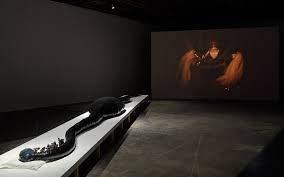Wangechi Mutu employs Print Media as an agglomerated means of communicating conceptually and physically to bring out a layered and intense depth and message to her artistic work. She uses images and papers cut from fashioned and modernized magazines about African art, and National Geographic combines such pieces to make her work more perfect and elegant. Sampling from a broad population, Mutu would end with a masterpiece that would pass on the intended message and do it with a touch of authentic art, uniqueness, and class (Artists | Art21, n.d.). Born in Nairobi, Mutu began her art journey by combining ink with cutouts from magazines and documentaries, thus, at this moment Mutu combines different materials and techniques to depict the complexity of life.
Mutu has created a video fusion; the fusion also creates a uniqueness that accompanies her works. Her portraits are mostly cutouts, and her videos are controversial and influential (Hernandez, 2017). Most artists mostly use their paintings to communicate to their audience, limiting the number of people that the message reaches and creating a fixated conception about the work by the artist. However, Mutu has incorporated a mechanism that makes her works stand out in the world of art and has also broadened the audience by attracting more people to the world of art. Mutu has also gone ahead and addressed the issue of how the female bodies are perceived, especially the black female bodies, making elegant female bodies from the mixture of cutouts from all sorts of sources, informing the public about the female bodies, and also empowering black women to feel confident in their color.
One of her notable works is Nguva na nyoka. The name comes from Swahili words meaning “sirens and serpents.” Mutu creates a piece accompanied by a video that depicts a hybridized figure of a woman with a controversial mixture of materials such as Kenyan soil, tea, synthetic hair, and sand, all of which supposedly have their cultural significance. The video accompanying the piece shows an aquatic character who emerges from the sea and wanders around restlessly and viciously.
Another piece from her works is the End of eating everything. The End of Eating Everything is an animation video 8 minutes long that conveys a strong message to the world in general. The animation has Santigold playing the role of a mothership planet-like creature. Her Medusa-like hair perfectly creates a crown for the creature, and her body has pores that, like factory chimneys, churn out clouds of black smoke. The creature cannot resist eating a flock of blackbirds that she encounters to satisfy her gluttonous nature. Blood is seen spilling after she eats the birds; the oversized creature then explodes into a black cloud of smoke. As the smoke rises above, a new dawn is seen, and the smoke cloud brings a new set of hatchlings.
Mutu creates a fusion of video and portraits art into a masterpiece that explicitly passes the information to the masses. She focuses on the art-loving audience and those who do not love standing in galleries looking at portraits. The portraits are like a skeleton, with no flesh to drive canines in for the audience, while the videos offer a diverse buffet to the audience, each choosing to eat what seems to suit their appetite. Her works break the boundaries that have kept art, especially contemporary art, away from the ordinary person; she tries to be inclusive by using all mediums available to inform, educate, and criticize her audience. The issues she talks about, feminism, cultural diversity, slavery, colonial history, and African history, are issues that are heavily debated; they touch most aspects of every living human being. Therefore, it is common knowledge that her works should reach everyone and speak to them in a language they understand.
The End of Eating Everything is one of Mutu’s works primarily discusses how humans are gluttonous by nature. She tries to communicate how this state of humans destroys the world we live in (Jørgensen, 2020). The creature represents broad aspects that encompass human lives, the activities we participate in, and the facilities and tools we have created to aid us in our lives. Like Medusa, the creature’s hair dehumanizes the very activities that we have created, showing how we have driven ourselves into a pit of destruction, and the flock of blackbirds is us, the humans. The creature ends up eating the birds in a gruesome manner, but all is not lost as a new generation of hatchlings rises from the rubble, and a new dawn is seen.
The new dawn is a sign of hope in humanity, a generation conscious of the environment and the earth. Her works are fascinating, mind-blowing pieces that form a bigger picture. Art has always provided a platform that lacks censorship. Mutu exploits that by talking about issues that many shy away from; the diversity of her ideas and concepts constantly pokes the mind (“Mutu, Wangechi,” 2019). The works allow us to see the world through an uncensored lens which enables all to see the world through the eye of a unique artist whose aim is to see a positively changing world. Mutu is not afraid of exploiting social and personal weaknesses, and she makes hybrid figures that depict women and their flaws. She creates mythical creatures that show our human weaknesses. She makes it easier to understand the world by allowing us to see the world and how to change, like seeing the world through the eyes of a child; below is some of her work (Wangechi Mutu: Nguva Na Nyoka | Victoria Miro, n.d.).

References
Hernandez, J. (2017). The ambivalent grotesque: Reading black women’s erotic corporeality in Wangechi Mutu’s work. Signs: Journal of Women in Culture and Society, 42(2), 427-457.
Jørgensen, S. M. H. (2020). Vocalizing Dystopian and Utopian Impulses The End of Eating Everything. The Bloomsbury Handbook of Sound Art, 89-104. Web.
Artists | Art21. (n.d.). Web.
Wangechi Mutu : Nguva na Nyoka | Victoria Miro. (n.d.). Web.